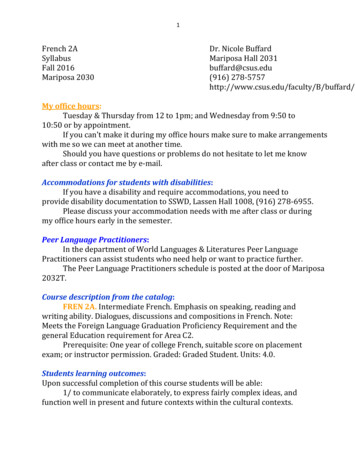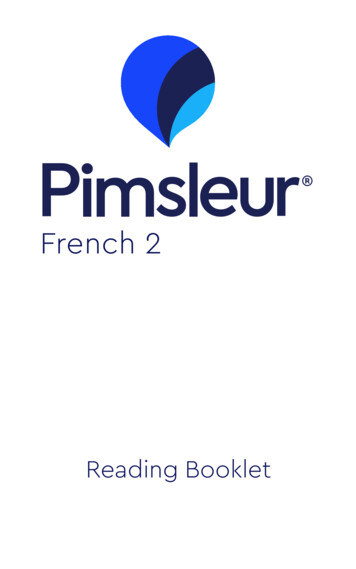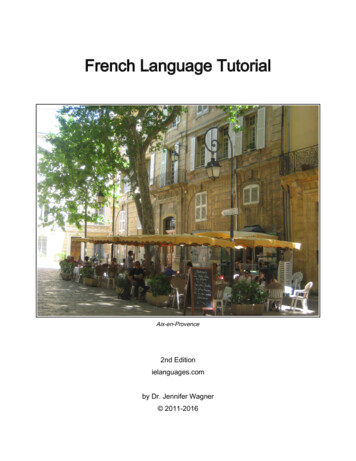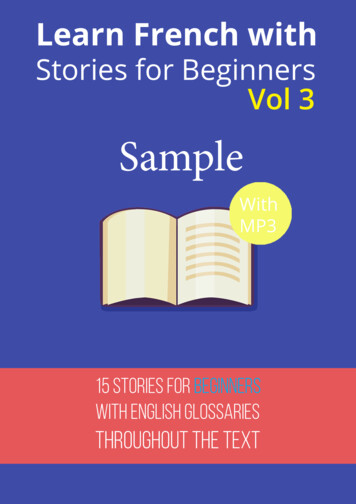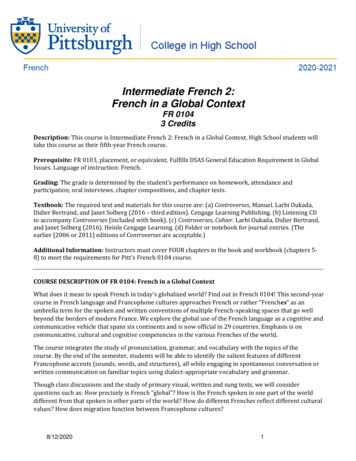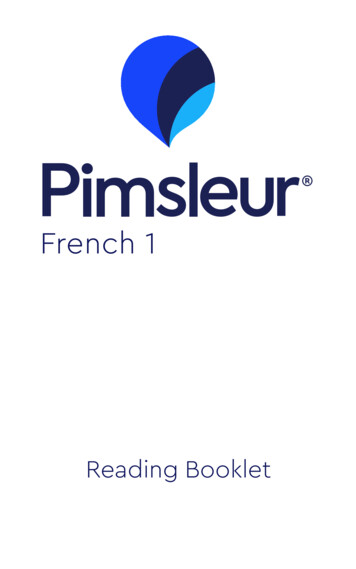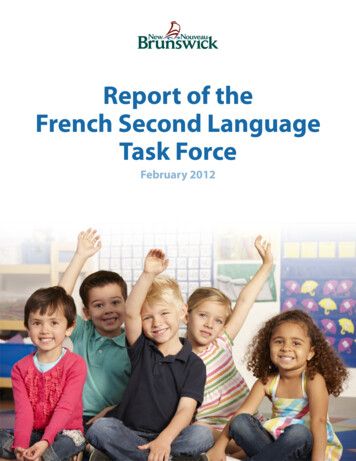
Transcription
Report of theFrench Second LanguageTask ForceFebruary 2012
Table of ContentsThe Process. . . . . . . . . . . . . . . . . . . . . . . . . . . . . . . . . . . . . . . . . . . . . . . . . . . . . . . . . . . . . 1The Context . . . . . . . . . . . . . . . . . . . . . . . . . . . . . . . . . . . . . . . . . . . . . . . . . . . . . . . . . . . . 4Data Gathered from the Web Survey. . . . . . . . . . . . . . . . . . . . . . . . . . . . . . . . . . . . . 5What We Heard. . . . . . . . . . . . . . . . . . . . . . . . . . . . . . . . . . . . . . . . . . . . . . . . . . . . . . . . . 7What the Research Says. . . . . . . . . . . . . . . . . . . . . . . . . . . . . . . . . . . . . . . . . . . . . . . . . 9Myth Busting . . . . . . . . . . . . . . . . . . . . . . . . . . . . . . . . . . . . . . . . . . . . . . . . . . . . . . . . . . 12The Real Question. . . . . . . . . . . . . . . . . . . . . . . . . . . . . . . . . . . . . . . . . . . . . . . . . . . . . . 15Recommendation. . . . . . . . . . . . . . . . . . . . . . . . . . . . . . . . . . . . . . . . . . . . . . . . . . . . . . 17General Task Force Concerns . . . . . . . . . . . . . . . . . . . . . . . . . . . . . . . . . . . . . . . . . . . 19Table of recommendations. . . . . . . . . . . . . . . . . . . . . . . . . . . . . . . . . . . . . . . . . . . . . 20Bibliography. . . . . . . . . . . . . . . . . . . . . . . . . . . . . . . . . . . . . . . . . . . . . . . . . . . . . . . . . . . 21
The ProcessThe terms of reference for the work of the Task Force were provided before the members met. They includedthe following mandate: Provide direction/options for outcome and program improvements to either the Grade 1 or Grade3 Early French Immersion entry point or program, depending upon the option recommended andaccepted by Government. Consult with the Ministerial Advisory Committee on French Second Language Review both beforeundertaking public consultations and once preliminary recommendations are complete. Review background analytics on student results for the Grade 1 versus Grade 3 entry points. Undertake public consultation on the entry point for Early French Immersion on behalf of theGovernment of New Brunswick. Review all briefs and materials presented to Government on the issue. Deliver a final report to the Minister of Education and Early Childhood Development by January 31,2012.The co-chairs met with the Minister and the mandate was summed up in two more precise questions. Thesequestions were put to the public at every public meeting as well as to stakeholders during consultations.1. What is best for the child who wants to learn a second language; grade 1 or grade 3 entry?2. What do parents want?Public meetings took place in November and December at 11 schools around the province from the followingcities. Campbellton Miramichi Bathurst Fredericton Moncton Saint John St. Stephen Woodstock Oromocto Sackville HamptonFurthermore, meetings took place with a sample of school staff including teachers and principals in eachlocation (173 participants). Included in these groups were literacy leaders, Immersion teachers, Englishteachers, resource and methods teachers, and intensive French teachers. We also met with 43 students, mostlyfrom high school but some from Grades 3 to 5 as well.The Task Force met on two occasions with the Ministerial Advisory Committee on French Second LanguageReview before drafting its report and once the first draft of the report was in the works.The Task Force members or co-chairs also met with a number of stakeholders including districtsuperintendents, Dr. J. Douglas Wilms, Dr. Joseph Dicks, Dr. Ann Sherman, former minister Kelly Lamrock,district learning specialists and a representative of First Nations.Report of the French Second Language Task Force1
A web-based questionnaire was made available to the public for a period of 6 weeks. Over 350 peopleresponded to the following questions: What are your language ability expectations of French Immersion? In your opinion, what are the strengths and weaknesses of a Grade 1 entry point versus a Grade 3 entrypoint? Please provide examples or observations. Please describe your experience with each of the French Immersion entry points (Grade 1 and/orGrade 3). What are the major challenges and/or benefits with the province maintaining the current entry pointof French Immersion? Is the current goal of meeting the 70% advanced proficiency for the Grade 1 or Grade 3 entry pointsrealistic? Please explain your choice. What specific barriers may relate to the government’s goal of 70% of Anglophone students achievingthe Advance proficiency in French Immersion? In your opinion, what is the ideal time for students to begin learning a second language and why?The above questions were also used as a launch pad for all the consultations. They served the Task Force wellas they created a context for discussion.Biographies of the members of the French Second Language Task ForceJames E. Lockyer, co-chairLockyer is a professor and former dean at the law faculty at the Université de Moncton, where he teachestrial advocacy, appellate advocacy, civil procedure and commercial law. Lockyer is a past president of the LawSociety of New Brunswick and past member of the New Brunswick Law Foundation. He was a member ofMoncton council from 1983 to 1987.Lockyer served as an MLA from 1987 to 1999. He was attorney general and minister of justice for five years. Healso served as minister of education, minister of supply and services and solicitor general. He was a member ofvarious legislative and cabinet committees. He was appointed Queen’s Counsel in 1987.Active in community affairs, Lockyer is a former board chair of the Greater Moncton YMCA. He is a formermember of the board of directors and executive of the Moncton Flight College. He was a vice-president of theMuriel McQueen Fergusson Foundation and vice-president of the Tree of Hope Campaign. He was chair of theorganizing committee of the 2009 Ford World Men’s Curling Championship. He spent many years as a memberof the Canadian Forces Reserve.Elvy Robichaud, co-chairRobichaud is a former teacher, principal and hospital administrator. He received his B.PhysEd, BA and MA atthe Université de Moncton.Robichaud served as an MLA from 1994 to 2006. He was minister of education from 1999 to 2001. He alsoserved as minister of health and wellness for five years. He was minister responsible for the Office of HumanResources and the Culture and Sport Secretariat. A former official Opposition house leader, Robichaud servedon a number of legislative committees, including the standing committee on proceedure, law amendmentsand public accounts as well as the select committee on demographics.Active in his community, Robichaud has been a Tracadie councillor, board chair of the Hôtel-Dieu Saint-Josephin Tracadie, president of the New Brunswick Special Olympics and treasurer of Leisure New Brunswick.Report of the French Second Language Task Force2
Linda LowtherLowther has 32 years of experience in education. In 2011, she retired as assistant deputy minister of the PrinceEdward Island Department of Education and Early Childhood Development, where she held various positionsin the field. Lowther was a teacher, a French co-ordinator within a school board, a curriculum consultant at theDepartment of Education and Early Childhood Development, director of French programs and senior directorof public education.In her senior positions with the Island’s Department of Education and Early Childhood Development, Lowtherwas a member of the Task Force on Student Achievement and chair of the Kindergarten Transition Team. Shehelped with the deployment of the Pre-School Excellence initiative.Her educational volunteer work included the founding of the Prince Edward Island French Immersion Teachers’Association and various executive positions with the Canadian Association of Immersion Teachers.Paul-Émile ChiassonChiasson is the Education / Teaching English as a Second Language co-ordinator at the University of NewBrunswick, Saint John campus. He received his BA and BEd from St. Francis Xavier University and a BA fromLaval University. He later obtained his MA and PhD from the Université de Franche-Comté in France. He joinedthe faculty of arts, University of New Brunswick, Saint John campus, in 2004. He has taught the Certificatein Teaching English as a Second Language program since its inception in 1998. He has been awardeddepartmental and faculty awards for teaching excellence.Chiasson specializes in education and second language teaching. Author of several articles, he has conductednumerous workshops and training on English and French as an additional language in Korea, China and NewBrunswick.Prior to present role, Chiasson taught immersion and French core in school districts 6 and 8 for 27 years. Heserved as the French second language learning specialist in School District 8.Report of the French Second Language Task Force3
The ContextA French immersion program was first attempted in 1965 in SaintLambert, Quebec, when a group of English speaking parents wantedtheir children to be able to communicate in French and reach out toother native French speakers.French Immersion is a type of bilingual education in which studentsreceive instruction in French for a significant portion of the schoolday. It is designed specifically for students whose mother tongue isnot French. The approach used is often called ”the gentle approach”as children learn the language through daily use in the classroomrather than by rote learning.Lambert and Tucker (1972) found that parents choosing to entertheir children in French Immersion were motivated by their desire tohave their children:- meet and converse with more and varied people;- understand members of the other group and their way of life;- develop friendships with members of the other group; and- get good jobs.French Immersion programs were widely introduced into Canadianschools, including in New Brunswick, in the 1970s to encouragebilingualism across the country. Now forty years later, immersionprograms provide an alternative education stream for manystudents.French Immersion entry points have changed a number of times inNew Brunswick. In 2008, the Department of Education proposedthe abolition of Early French Immersion in favour of an immersionprogram beginning in Grade 6 (Late Immersion). After a publicoutcry and a judicial decision a compromise was made to effect achange of the entry point from Grade 1 to Grade 3.The present Government, as part of its election platform, promisedto re-visit that decision within the first year of its mandate. Thisreport is the result of that commitment.Whether learning a second language, in this case French, isbeneficial or not is no longer debatable. Regardless of the program,learning a second language provides many social and academicbenefits, including a better understanding of French and Frenchspeaking cultures, a facility for other languages, brain developmentthat facilitates other learning, delays the onset of dementia, andprovides a greater number of career options.Report of the French Second Language Task ForceThe year French Immersionstarted in Canada: 1965The average number ofstudents in French Immersionin Canada each year: 328,000The number of students inFrench Immersion in NewBrunswick in 2000: 22,664The number of students inFrench Immersion in NewBrunswick in 2010: 17,454Provinces with the largest % ofstudents in French Immersion:NB, Quebec and PEILanguage proficiencyexpectations of participantsin the process: 86% expectIntermediate plus or higherand 50% expect advanced orhigherFrench is spoken by about128 million people in 54countries. It is an officialworking language of theEuropean Union, the UN,the International Red Cross,the International OlympicCommittee and NATO.4
Data Gathered from the Web SurveyOver 350 people filled out the online survey. Of those, less than half had children in Immersion. The firstquestion asked about the respondents’ language ability expectations of French Immersion. More than half(51.5%) expect an advanced level of proficiency and another 34.8% expect at least an intermediate plus level.A total of 86.3% of respondents wanted an intermediate plus or higher degree of proficiency. Clearly there is ahigh expectation of proficiency on the part of respondents.The answers in response to the second question asking what are the strengths and weaknesses of a Grade 1entry point versus a Grade 3 entry point were:Strengths of Grade 1 Entry Point vs. Grade 3 entry point Sponges/Ability to Soak Everything in/Early Exposure at 30% Learn basic concepts of both languages at once/think not translate/Learning a 2nd language is naturalpart of school at 16.3% Less inhibited/shy/resistant/self-conscious, more confident at 14.6% Better French accent/Less noticeable English Accent/pronunciation at 8.9% Build vocabulary at 4.0% Less streaming than Grade 3 Entry/More inclusionary/Less disruption and more social networks at3.1% Inter provincial mobility for students at 1.4% Availability of similar curriculum and resources at 1.1%Weaknesses of Grade 1 Entry Point vs. Grade 3 entry point Need to lay strong foundation prior to introducing new language at 42.9% Streaming more pronounced/does not allow for early interaction 10.3% Parents do not yet have understanding of capabilities of own child 7.4% Fatigue by end of Grade 6/Exit Program at Disadvantage at 1.4%In describing their experiences with each of the French Immersion entry points respondents with Grade 1experience said that children were able to converse competently and had higher proficiency (17.9%), weremore likely to be proficient later in life/keep it up/speak and not translate (6.2%), influenced work habits/concepts that helped later in school (3.5%), had positive experiences/ gains without losses (3.2%), betterpronunciation/French accent (2.9%). The top negative points included worry/reality that they will not be/arenot as proficient in English (4.4%), that streaming occurs – top students to FI/most pronounced (3.5%) andthat it is a shock to go from English kindergarten to Immersion Grade 1 (2.9%).Respondents with Grade 3 experience said that children were able to build a foundation in English first(20.8%), that students know themselves/more confident/understand school (4.1%), and that there is time forparents/teachers to assess (3.2%). Respondents also said that children may not want to try to start this late/Discouraged/Reluctant (7.0%), that adjusting to the language distracts from success in other subjects (2.9%)and that the program is less universal/more elitist/streaming still occurs or more (1.8%).Respondents identified many factors in identifying the major challenges and/or benefits with the provincemaintaining the current entry point of French Immersion. Challenges included: less opportunity to build vocabulary/lost time (15.5%), being more expensive due to lack of availability of similar curriculum (8.5%),Report of the French Second Language Task Force5
lack of patience/can we afford to experiment/public support (7.3%), children less able to soak everything in (7.0%), streaming – by language/by ability/by economic background (4.7%), evidence does not support it/nobody else doing it (4.7%), loss of competitive advantage for Province/mobility (4.1%), needing enough FI teachers to sustain program (3.5%), more inhibited, shy, resistant and self-conscious (3.2%), unable to learn basic concepts of both languages at once (1.2%), split up families/friends with late entry due to school change (1.2%), more likely to enter francophone only stream (0.9%), those with less engaged parents will suffer, (0.9%), and less French spoken in school with K-2 FI removed (0.9%).Benefits of maintaining the Grade 3 entry point included: the costs and burden of switching/desire for Stability (21.7%), strong foundation built prior to introducing new language (17.3%), good so far/stay the Course/need complete cohort for study (13.5%), parents have better understanding of capabilities of own child (5.0%), better than later entry points as an alternative (2.1%), pick one and keep it (2.1%), inclusion in K-2 classes/balanced classrooms (1.8%), frees up teachers/resources that could be used elsewhere (1.5%), and less likely than EFI (1) to drop out and return to system behind (0.9%).When asked if the current goal of meeting the 70% advanced proficiency for the Grade 1 or Grade 3 entrypoints is realistic, 20.3% said no, 35.3% said yes while 19.4% said yes if certain issues were addressed such asthe high school drop off due to lack of courses/university prep (7.1%), parents/home environment a barrier(7.1%), needing more resources and support (6.5%).The above issues were further addressed in question six which asked what specific barriers may relate to thegovernment’s goal of 70% of Anglophone students achieving the Advance proficiency in French Immersion.Answers included money/resources/lack of support services (23.0%), lack of practice/community usage(17.3%), lack of French course offerings in high school/university preparation (15.5%), lack of parental support(14.3%), teacher ability/proficiency (8.4%), late entry/not starting in Grade 1 (8.1%), attitude/motivation/incentives ( 7.8%), changes to the system/politics ( 5.4%), starting too early (2.4%), streaming leads tostruggling students that should not have been in program (1.5%) and needing more benchmarks/testingbefore high School (1.2%).The final question asked respondents what is the ideal time for students to beginlearning a second language. Fifty-two per cent (52%) said the earlier the better,kindergarten or grade 1, while 28% said grade 3. Other options were suggestedand each one of them generated less than a 5% response rate.Report of the French Second Language Task Force6
What We HeardNotes were taken at all consultations and the analysis of those notes strongly mirrors the answers givento the questions available on line with a few modifications. Approximately 301 members of the publicattended the eleven consultations. An intermediate plus or higher level of proficiency was expected by84.6% of participants. Benefits and challenges of the two programs were similar but may have varied by a fewpercentage points.The most notable differences came from instructional personnel (173 participated) who work every daywith students. Teachers are, of course, very protective of their own field of expertise, with French teacherstaking an earlier the better approach (grade 1). Yet, when pushed, many administrators and English teachersacknowledged that the best way to learn a second language was as early as possible. If they were promotingthe status quo, it was with a view to other questions regarding the system as a whole.Most educators agreed that streaming was an even bigger issue now. Because parents are more “sure” abouttheir child’s abilities, the students entering immersion tend to be the stronger students. This is not a surprise tous. The same phenomenon happens in late immersion.Immersion teachers pointed out the challenges they have had over the years in obtaining appropriatecurriculum and resources. The majority of Immersion teachers noted that they wished they had had thesame type of curriculum when they were teaching grade one and two. They also described the challengesexperienced by students in grade 3 and 4 who were trying to learn math and other content area subjectswithout having had the base academic vocabulary in French they would have learned in grades one andtwo. Not that it was too difficult, but rather that the time in which to learn it and master the concepts createdintense pressure on the students and teachers to cover the curriculum. This message then compounds thestreaming issue as only the “best” students can keep up. Immersion teachers also spoke of the difficulty offinding reading resources that were of high interest with easy enough vocabulary for children in grades threeand four. Children of that age are very conscious of being given anything that will look to young for them.The public consultations were held in a “world café” style. This type of consultation ensures that everyonehas a voice as participants are grouped at smaller tables and a facilitator guides the participants throughthe discussion. It allowed for all points of view to be put forward in a respectful manner. We asked all publicconsultation tables to report back at the end of each meeting if they preferred a Grade1 or a Grade 3 entrypoint. Thirty-six of fifty-four 36/54 tables or 66% said Grade 1 or earlier.Administrators and superintendents, as well as some people in the public are fearful of changing back tograde 1 because they fear chaos and change itself. In a time when there are many educational changeshappening, we understand the concerns. However, we have faith that educators are resilient leaders whohave the future of New Brunswick children in mind and who can, when given the opportunity, come up withcreative, rather than reactive, solutions.There were concerns expressed about the cost of Immersion programs. There is also little understanding ofsecond language funding and the contribution made by Canadian Heritage to second language budgets. In ashrinking world and obvious global economy, the ability to speak two or more languages is often cited as oneof the top competencies required in the job market. Investing in creating more competent French speakersmakes sense.On another note, a significant number or parents and teachers acknowledged that there was little, if anything,going on in French in grades one and two although there is supposed to be 30 minutes of activity. This, inspite of a Department survey of the system that concludes otherwise.Report of the French Second Language Task Force7
We would like to take this opportunity to thank, parents, educators, administrators and members of the publicfor their genuine participation in this process. Many comments were received on line and through email.Those who spoke during consultations did so because they cared and were committed.We also spoke to 43 students in elementary and secondary grades. We thank them for their sincere passionand for their honest participation. It was evident that students in grade 4 from the grade 3 entry point werestill at the initial stages of building vocabulary. It was also evident that high school students very much valuedsecond language learning and wished more opportunities were offered to them. The high school students wemet indicated they supported a grade one entry point in the same ratio as our findings with other groupsi.e. 66 percent. Many of the students in that group were clear, and some even adamant, that the grade 1entry point was important, interestingly enough even more so than adults as the debate amongst studentsshowed us.Finally, it should be noted that there was a fear that the on line survey may have been overtaken by out ofprovince respondents. It is suggested that this not happen and we are not concerned by that fear as thecomments were not out of line with what we heard in person from New Brunswickers at public consultations.Report of the French Second Language Task Force8
What the Research SaysAs members of the Task Force, we were given access to many reports and studies and did some research of ourown. It is important to note that we read all data that was provided to us including literacy scores, PISA results,enrolment data and trends, and reports done by previous authors involved in the debate. In some cases, wefound information to be frustrating as it could be interpreted in many ways. In other instances, authors startedfrom a deficit model rather than a strength model; looking at what was weak rather than what was strong andbuilding from there. Our role here is not to cite the hundreds of pieces of literature but to sum up what wefound.Because our mandate was very specific to the entry point and improvements to the program, weconcentrated on what the research says about the best age for learning a second language and whatconstitutes a great program.Is “the earlier the better” really better?There are as many opinions as to when it is best to learn a language. Bista and Dicks (2009) in their reviewsnoted that researchers can have various points of view. Some say that adults or older students learn faster orbetter because they process syntax and complex problems more quickly, are learning for a specific reason andare thus more motivated.Other researchers speak of a critical time, usually between ages 5 and 9, where children learn more naturally.Other factors such as the amount of time and exposure and the learning environment contribute to the levelof proficiency acquired by the learner. We often saw the younger the better versus the older the better in theresearch debates.We were asked to consider what is best for the child. In doing so, we note that most research on childrenlearning a second language promotes the younger the better approach. Young learners tend to become morefluent, have more vocabulary and achieve a native like accent.As importantly, we considered the fact that more children of various abilities are apt to become proficient ifstarting at an earlier age. Thus, learning a second language does not become only the domain of those alreadyidentified as highly successful. Instead, learning a second language gives a cognitive and cultural advantageto a wider number of students. Wesche notes: “early total immersion has particular appeal for contexts inwhich the societal goal is for a large proportion and broad range of children to develop functional skills in asecond language.” Dicks said it best: “If we want students with the widest range of abilities to achieve a highlevel of bilingualism, we need to start early. . These students often have the most to gain with regard toconfidence and self-esteem, as well as the economic advantages that come from having such a valuable skillas bilingualism when they enter the workforce.”Marty Abbott of the American Council on the Teaching of Foreign Languages was recently quoted as saying:“When you expose young children to another language, they really end up with a native pronunciation andintonation, which is harder to develop later on, and it also works a different part of the brain. We always talkabout the cognitive benefit of learning another language at an early age, and there are also academic benefits,like increased proficiency in language arts.”Task Force members were also specifically interested in the cognitive and cultural domains because they aretwo of the most important benefits of learning a second language. With the advances in brain research andabout how children learn, we are most intrigued in the potential that learning a second language adds to achild’s abilities.Report of the French Second Language Task Force9
In both behavioral and brain imaging studies, we found that the age of bilingual language exposurehas a significant impact on children’s dual language mastery. Remarkably, early age bilingual exposurehas a positive impact on multiple aspects of a child’s development; here, involving language andreading. Children who experience early, extensive, and systematic exposure to both of their languagesquickly grasp the fundamentals of both of their languages and in a manner virtually identical to that ofmonolingual language learners The field raised concerns that early bilinguals may be linguistically,cognitively and academically disadvantaged On the contrary, young bilinguals may be afforded alinguistic and reading advantage Laura-Ann PetittoAnd, in the most recent issue of the national Canadian Parents for French newsletter, internationally respectedresearcher Joan Netten, clearly makes a case for an early entry point and says that Early French Immersion isthe optimal entry point for the widest variety of student academic abilities.Every other province and territory starts early immersion in kindergarten or grade 1 and most in kindergarten.From a practical point of view, curriculum can be shared or borrowed from other jurisdictions; resources aremore readily available, and training programs are geared to the primary grades. Not a single other jurisdictionthat we could find begins in grade 3.What constitutes a great Immersion program?Wesche (2002) posed the question herself: “Given several decades of accumulated experience, what are thecore features of a successful program? What do the successes and failures of experiments with immersionand content-based language instruction tell us about how second languages can be most effectively taughtin school settings? Substantial research supports the following conclusions: Early starting age, intensity ofinstruction and continued exposure over many years, and learning of substantive school content as a vehiclefor L2 (second language) learning.”Wesche also notes the importance highly fluent, including native speaker teachers, as well as the availability ofappropriate source materials in the language, and parental – and ongoing political support.She and other researchers prescribe well trained teachers and appropriate pedagogy which includes activities that are meaningful and contextualized; the development of all language skills: listening, speaking, reading, wr
receive instruction in French for a significant portion of the school day . It is designed specifically for students whose mother tongue is not French . The approach used is often called "the gentle approach" as children learn the language through daily use in the classroom rather than by rote learning .
